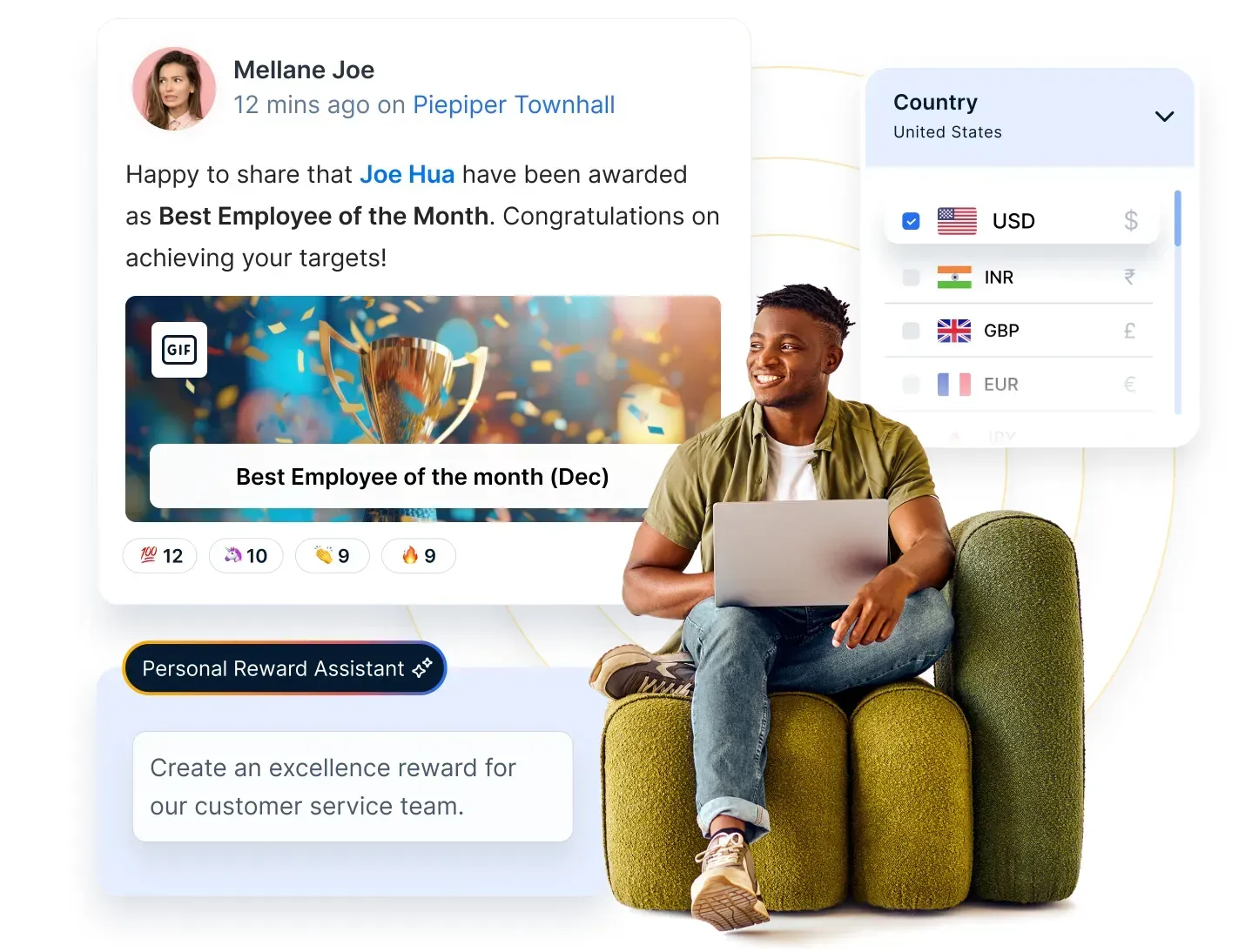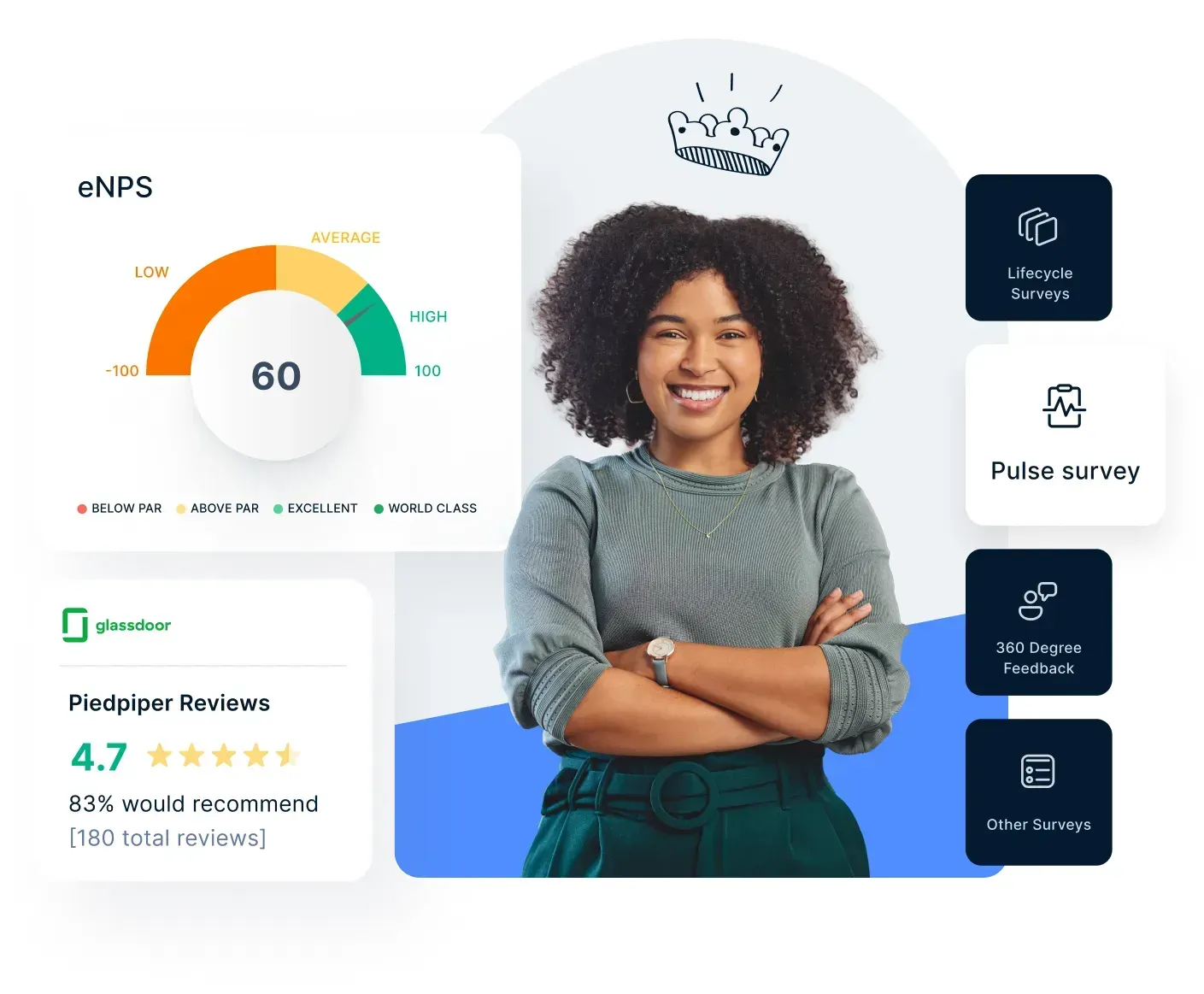Cómo mejorar la retención de empleados: 13 formas creativas de retenerlos
Descubra cómo mejorar la retención de los empleados abordando los retos clave, mejorando el compromiso y creando un entorno de trabajo que les encante.
En esta página
- ¿Qué es la retención de los empleados?
- Retención de empleados
- ¿Cómo calcular el índice de retención de empleados?
- Cómo mejorar la retención de empleados: Las 13 estrategias más eficaces
- Lista de control para el seguimiento de la retención de empleados
- Reforzar la retención de empleados con Empuls
- Conclusión
Uno de los mayores problemas de las empresas es mejorar la retención de los empleados. Según datos de la Oficina de Estadísticas Laboralessólo entre julio y noviembre de 2022, más de 4 millones de estadounidenses abandonaron voluntariamente sus puestos de trabajo.
Para corroborar este estudio Gartner ha revelado que el sector empresarial podría registrar una tasa de rotación de hasta el 24% en los próximos años, lo que implora a las organizaciones que pongan en marcha mejores estrategias de retención de empleados.
Los empleados se consideran el mayor activo de una organización, y el segundo son los clientes. Si trata con cuidado a sus empleados, ellos reflejarán este sentimiento a sus clientes, lo que le diferenciará del resto del mercado. La clave para ello es el compromiso de los empleados.
A estudio de Gallup ha demostrado que las organizaciones con empleados muy comprometidos pueden notar una rentabilidad un 21% mayor, lo que exige aplicar estrategias probadas de retención de empleados. Tomemos como ejemplo grandes marcas como Facebook, Amazon, TATA y Google. Estas son algunas de las organizaciones que tienen algo en común: contratan talento y lo conservan.
En el competitivo mundo actual, los trabajadores altamente cualificados pueden sentirse obligados a cambiar de trabajo si reciben una oferta mejor. Un empleado que no se siente comprometido y respetado o que no progresa en su empresa empezará a buscar otras opciones mejores.
Así pues, desea reducir la rotación de personal y mejorar la productividad. En ese caso, crear una estrategia eficaz de retención de empleados debe ser una prioridad en su lista de tareas pendientes.
¿Qué es la retención de los empleados?
La retención de empleados engloba los esfuerzos generales de una organización para evitar que sus empleados se marchen. Desde una perspectiva mucho más amplia, se trata de crear un entorno en el que los empleados experimenten las tres R fundamentales de la retención de empleados: respeto, recompensa y reconocimiento.
Los programas de retención de empleados pueden variar en función de las carencias de la empresa. He aquí algunos ejemplos:
- Implantación de grupos de apoyo entre iguales o asesoramiento gratuito
- Integración de tecnología de IA como Generadores de imágenes AI, creadores de presentaciones de diapositivaso software de redacción para automatizar tareas y facilitar el trabajo.
- Trabajo flexible y a distancia
- Tutoría inversa, en la que los empleados dan su opinión a sus superiores
Construya estos programas con los valores fundamentales de la retención de empleados y disfrute del principal beneficio de una mejor experiencia de los empleados: la contratación de los mejores talentos que se quedan.
Mientras tanto, hay un informe Gallagher que predice el estado de la retención de empleados en 2024. Dice que el 57% de las organizaciones esperan un aumento de la plantilla. La retención de empleados sigue siendo una de las principales prioridades operativas, lo que pone de relieve la necesidad de que las empresas amplíen sus esfuerzos para evitar que los empleados se marchen.
Retención de empleados
Retener a los empleados va más allá de ofrecerles un sueldo. Las empresas deben abordar los principales retos que afectan a la satisfacción laboral, la implicación y el compromiso a largo plazo. Al identificar estos obstáculos y poner en práctica formas creativas de retener a los empleados, las empresas pueden construir un lugar de trabajo en el que los empleados se sientan valorados, motivados y con ganas de quedarse.
1. Falta de oportunidades de crecimiento profesional
Los empleados suelen marcharse cuando se sienten atrapados en el mismo puesto sin una vía clara de promoción. Las empresas que no ofrecen formación, tutoría o ascensos corren el riesgo de perder a sus mejores talentos en favor de la competencia. Los programas de desarrollo profesional y los talleres de desarrollo de habilidades son formas creativas de retener y mantener el compromiso de los empleados.
2. Compensación y prestaciones inadecuadas
Unos salarios y prestaciones competitivos son esenciales para retener a los empleados. Si los empleados se sienten mal pagados o sus prestaciones no cumplen las normas del sector, es más probable que exploren otras oportunidades laborales. Ofrecer bonificaciones basadas en el rendimiento, programas de bienestar y ventajas personalizadas pueden ser formas creativas de retener a los empleados al tiempo que se mejora la satisfacción laboral.
3. Mala conciliación de la vida laboral y familiar
Los empleados que luchan por mantener un equilibrio entre el trabajo y la vida personal suelen sufrir agotamiento. Los horarios rígidos, las cargas de trabajo excesivas y las expectativas poco realistas provocan insatisfacción y aumentan la rotación. Introducir modalidades de trabajo flexibles, opciones de trabajo a distancia y permisos retribuidos adicionales pueden ser formas creativas de retener a los empleados y mejorar su bienestar general.
4. Falta de reconocimiento e incentivos
Los empleados necesitan sentirse valorados y apreciados por sus contribuciones. Cuando las organizaciones no reconocen los esfuerzos o recompensan los logros, la motivación y la lealtad disminuyen. Implantar programas de incentivos, plataformas de reconocimiento de empleados y recompensas no monetarias son formas creativas de retener a los empleados y fomentar una cultura de aprecio.
5. Cultura de empresa y compromiso débiles
Un entorno de trabajo tóxico, un liderazgo deficiente y la falta de colaboración en equipo pueden ahuyentar a los empleados. Los empleados que no tienen un sentimiento de pertenencia tienen menos probabilidades de seguir comprometidos con la empresa. Fomentar la comunicación abierta, promover la inclusión y organizar actividades de creación de equipos son formas creativas de retener a los empleados y reforzar la cultura del lugar de trabajo.
¿Cómo calcular el índice de retención de empleados?
RR.HH. debe contar con medidas específicas para rastrear las estadísticas de la tasa de retención de empleados cuando se habla de estrategias de retención de empleados. Cuando rastree dichas estadísticas, sabrá qué iniciativas procesables podrían utilizarse para frenar las tasas de retención de empleados.
Calcular el índice de retención de empleados es sencillo: Divida el número total de empleados que se marcharon durante un periodo entre el número total de empleados al final de un periodo para obtener el porcentaje.
Período: 3er trimestre
Número total de empleados al inicio del 3er trimestre = 34
Número total de empleados que se marcharon en el 3er trimestre 4
Cálculo: 34-4 =30
Tasa de retención de empleados = Número total de empleados que abandonaron durante un periodo
Número total de empleados al final de un periodo
Tasa de retención de empleados = 30 / 34 = 88%
Una investigación del Center for American Progress afirma que el coste de sustituir a empleados/directivos altamente cualificados puede superar fácilmente el doble de su salario anual. El objetivo de toda empresa es contratar personal con talento y conseguir que se quede más tiempo.
Retener a los empleados no es tarea fácil. Un estudio reciente de Willis Towers Watson afirma que más de la mitad de las empresas de todo el mundo tienen dificultades para retener a algunos de sus empleados más valiosos.

Retenga a sus mejores talentos con un reconocimiento significativo
La retención de empleados comienza con el reconocimiento. Utiliza Empuls para crear una cultura de reconocimiento, recompensa y compromiso continuos que mantenga a los empleados motivados y comprometidos.
Cómo mejorar la retención de empleados: Las 13 estrategias más eficaces
He aquí algunos consejos para mejorar la retención de los empleados. Puede que algunos de estos consejos le resulten conocidos, mientras que otros pueden ser nuevos para usted, pero lo fundamental es que todos estos consejos le ayudarán a estimular la fidelidad a largo plazo de sus mejores empleados.
1. Analizar por qué los empleados se van
Si no sabe por qué los empleados abandonan su empresa, no podrá desarrollar una estrategia eficaz para conseguir que se queden.
En primer lugar, revise la tasa de rotación media de su sector: ¿es su tasa de rotación de empleados superior a la media?
La aplicación de un proceso de entrevistas de salida para los empleados que se marchan puede permitirle conocer las verdaderas razones por las que los empleados se marchan.
Al fin y al cabo, son más propensos a ser sinceros cuando se marchan, y si no les preguntas tú mismo, podrían contarlo todo en una reseña negativa en Glassdoor u otro sitio.
Fíjate en los patrones que ves una vez que has empezado a recopilar tus datos. ¿Recibes comentarios de varios empleados sobre problemas de equilibrio entre el trabajo y la vida privada, problemas con los directivos, problemas de cultura del lugar de trabajo, estancamiento en el desarrollo de la carrera profesional o algo más?
¿Qué está obstaculizando su estrategia de retención de empleados? No se puede solucionar un problema hasta que no se identifica.
2. Examine su estrategia de contratación
Todo empieza con la contratación. Las personas que te abandonan son las que contrataste en su día. Así que analice en profundidad su proceso de contrataciónincluyendo los requisitos del puesto, la descripción del mismo, los procesos de entrevista, la retribución y las prestaciones, las funciones y las responsabilidades.
¿Y está viendo que un gran número de empleados renuncian a los pocos meses de ser contratados porque el trabajo no era lo que pensaban?
Las descripciones de los puestos de trabajo deben ser una mirada honesta a la cultura de la empresa y una visión detallada y precisa de las responsabilidades del puesto.
Los empleados no deberían verse sorprendidos por los aspectos básicos del trabajo después de empezar, lo que significa que hay que ajustar algo en el proceso de contratación, de modo que se contrate a las personas adecuadas desde el principio y se establezcan las expectativas correctas.
3. Optimizar la incorporación de los empleados
El primer día en un nuevo lugar de trabajo suele ser muy similar a la experiencia que teníamos el primer día de colegio: los nervios, la emoción de conocer gente nueva, aprender cosas nuevas, etc.
Si bien es un reto para los nuevos empleados familiarizarse con el nuevo entorno, las personas, los procesos, las responsabilidades del trabajo, etc., también lo es para los directivos.
Es responsabilidad del director preparar al nuevo empleado para el éxito, haciéndole sentir cómodo con la organización y el equipo desde el principio (¡mucho antes de su primer día de trabajo!).
Un plan inteligente, bien pensado e individualizado para cada empleado que se incorpore puede ser de gran ayuda. Asegúrese de que los empleados no solo reciben información sobre sus funciones y responsabilidades, sino también sobre la cultura de la empresa y cómo pueden prosperar cada día.
Traza planes y objetivos para la primera semana, el primer mes, el primer trimestre, etc., para que tengan claro lo que se espera de ellos.
Gestos como hacer un anuncio en el portal de la intranet, presentar a los nuevos empleados, emparejarlos con un compañero o un mentor para ayudarles a pasar los primeros días pueden tener un gran impacto.
En resumen, la experiencia de incorporación de empleados debe estar tan planificada y pensada como la experiencia de incorporación de un cliente.
Los nuevos empleados participan en el programa "Noogler"que incluye formación exhaustiva sobre los valores de la empresa, herramientas y tareas específicas del puesto. Los estudios demuestran que las organizaciones con un proceso de incorporación sólido mejoran la retención de los nuevos empleados en un 82% y la productividad en más del 60%.
4. Invertir en el desarrollo de los empleados
Una inversión en conocimiento siempre paga los mejores intereses". - Benjamin Franklin
Una de las formas más sencillas de reducir la rotación de personal es ofrecer buenas oportunidades de promoción profesional. La principal motivo por el que los empleados abandonan una empresa es que no ven una carrera profesional satisfactoria a largo plazo.
Si no ofrece oportunidades regulares de desarrollo profesional y un sistema de promoción justo, los empleados se sentirán frustrados y empezarán a buscar trabajo en otros lugares.
Esto no significa que tenga que ascender a todos los empleados cada año: eso no es razonable, y sus trabajadores lo saben.
Pero sí quieren saber cómo podría ser su trayectoria profesional, tener conversaciones periódicas sobre la progresión de la carrera con sus jefes y saber que las oportunidades de ascenso están claramente establecidas y distribuidas de forma equitativa.
Perder personas por falta de oportunidades de aprendizaje es probablemente una de las peores formas de perder el talento. Se trata de personas curiosas, con ganas de aprender nuevas tecnologías, técnicas, procesos, etc. - y las personas curiosas suelen ser grandes empleados.
Estos empleados se lanzan a cualquier nuevo reto y piensan en soluciones creativas.
Animar a los empleados a aprender constantemente y a equiparse con las últimas tendencias y tecnologías del mercado evitará que se marchen.
Dé prioridad a la inversión en el aprendizaje y el desarrollo profesional de los empleados asignando fondos especiales para cursos en línea, reembolsando los gastos de matrícula cuando sea necesario, asistiendo a eventos del sector, seminarios web, conferencias, etc.
5. Seleccionar a los directivos adecuados y entrenarlos
Todos hemos oído la conocida frase "Los empleados dejan a los directivos, no a las empresas". Los directivos tienen un gran impacto en los empleados y los equipos.
Afectan directamente al grado de compromiso y motivación de los empleados y, por tanto, a la probabilidad de que sigan trabajando en una organización. Pero, ¿qué es lo que a los empleados no les gusta ver en sus directivos?
Desde tener favoritos hasta hacer insinuaciones inapropiadas, pasando por no comunicar lo suficiente, microgestiónno apreciar lo suficiente, no escuchar lo suficiente al equipo, no ser decisivo, no ofrecer suficientes oportunidades de aprendizaje, etc., puede ser extremadamente desmotivador y empujar a los empleados a abandonar la organización.
Una de las mejores formas de evitarlo y fomentar una buena relación directivo-reportero es dotar a los directivos de la formación adecuada, material didáctico, etc.
Proporcionar a los directivos suficientes fondos de libre disposición para recompensar a los miembros del equipo y estrechar lazos con el equipo en comidas/cenas también ayudará a romper el hielo. El uso de plataformas tecnológicas para una retroalimentación individualizada eficaz y el uso de plataformas de intranet social para conectar y colaborar con el equipo. plataformas de intranet social para conectar y colaborar con el equipo para conectar y colaborar con el equipo.
Seleccionar cuidadosamente a sus directivos y formarlos en habilidades de gestión a fondo, ayuda a que sus supervisores tengan éxito y a que sus empleados estén satisfechos.
6. Fomentar la socialización en el lugar de trabajo
Cuando hablo con personas que aman su trabajo y tienen amistades vitales en el mismo, siempre hablan de que su grupo de trabajo es como una familia. - Tom Rath
Tendemos a pasar una mayor parte de nuestro tiempo en el lugar de trabajo que con nuestras familias. Así que, ¿no crees que animar a los empleados a construir fuertes amistades en el lugar de trabajo ayuda al propósito de construir organizaciones fuertes, conectadas y felices?
Las amistades en el lugar de trabajo hacen que venir al trabajo sea menos obligatorio y más divertido y algo que esperar.
La socialización en el lugar de trabajo va mucho más allá de una copa con un colega el viernes por la noche o un día de trabajo en equipo.
Crear vínculos "compasivos" y "significativos" con los compañeros de trabajo puede contribuir en gran medida a crear una plantilla feliz y satisfecha.
Proporcione a sus empleados múltiples vías para romper el hielo y conectar, ya sea a través de eventos y celebraciones periódicas en la empresa o de potentes plataformas de comunicación.
La socialización en el lugar de trabajo contribuye en gran medida a retener a los empleados.
7. Establecer la confianza mediante una comunicación transparente
El mayor problema de la comunicación es la ilusión de que se ha producido. - George Bernard Shaw
Una gran comunicación es como un buen partido de tenis: consiste en grandes voleas.
La comunicación no es como hace décadas, cuando la dirección enviaba memorandos o pegaba anuncios en los tablones de anuncios sin que los empleados pudieran compartir sus puntos de vista y opiniones.
En el vertiginoso mundo actual, los empleados esperan estar al día de la evolución de la empresa y quieren expresar sus ideas y opiniones al respecto.
Las organizaciones más innovadoras y con más éxito no esperan a ver empleados desvinculados y con baja productividad. Aun así, invierten en una plataforma tecnológica que pueda conectar a los empleados, sin importar desde dónde trabajen, en qué parte del mundo o desde qué dispositivo se conecten.
Una plataforma digital de comunicación y colaboración como una intranet le permite explorar formas creativas de establecer la comunicación, mensajes rápidos de la alta dirección, breves conversaciones entre directivos y miembros del equipo, anuncios de RRHH o encuestas de opinión.
Estas plataformas ayudan a los líderes a estar conectados con todos los empleados y les dan amplias oportunidades para compartir sus opiniones, ideas, preguntas y preocupaciones. Esto envía un fuerte mensaje de que la voz de los empleados es vital para el éxito de la organización, aumentando así el compromiso y la retención.
8. Mostrar gratitud y reconocimiento
Reconozca y afirme a las personas cuando contribuyan a la misión que usted comparte. Hazlo y encenderás su propósito y su potencial. - Mike Byam
Una cosa sencilla que reduce en gran medida la rotación de personal es reconocer y agradecer a los empleados su duro trabajo.
Las estrategias para reducir la rotación de los empleados no siempre tienen que ser costosas y extensas; pueden ser tan sencillas como darse cuenta de que alguien ha hecho un trabajo excelente y decirle por qué aprecia su dedicación y su duro trabajo.
Puede hacerlo aplicando un programa de reconocimiento formal. Pero también es fundamental no ignorar los pequeños gestos. Los empleados que no se sienten adecuadamente reconocidos tienen el doble de probabilidades de renunciar en el año siguiente. dos veces más propensos a renunciar en el próximo año - lo que influye significativamente en los índices de rotación.
Y el 65% de los empleados afirma no haber recibido ningún tipo de reconocimiento por su buen trabajo en el último año, por lo que hay mucho margen de mejora en casi todas las organizaciones.
A nadie le disgusta que le digan lo bien que ha hecho su trabajo. El agradecimiento es algo que todo el mundo aprecia.
Por ello recompensas y reconocimientos influyen en gran medida en la motivación y el compromiso de los empleados, así como en el tiempo que permanecerán en la empresa. Crean entre los empleados la percepción de que la organización valora y respeta su trabajo.
Y no sólo eso, ayuda a los empleados a encontrar el foco y el propósito de sus actividades cotidianas. Tal es el efecto de las recompensas y el reconocimiento. Una investigación de Bersin & Associates demostró que las empresas con programas de reconocimiento muy eficaces que mejoran el compromiso de los empleados tienen un 31% menos de rotación voluntaria.
Acostúmbrese a dar las gracias a sus compañeros de equipo cuando hagan un esfuerzo adicional, ya sea con un simple "gracias" en la reunión semanal, un premio en la gala anual o un cheque regalo para mostrar su aprecio.
El reconocimiento es más poderoso cuando se hace "social". Ya sea un reconocimiento como empleado del mes o cualquier reconocimiento de equipo, cumpleaños o aniversarios laborales, los anuncios en las plataformas de intranet social unen a la organización en la celebración y levantan la moral de los empleados.
Además, contar con un programa estructurado de recompensas y reconocimiento ayuda a una organización a alinearse con sus valores y creencias y a reforzarlos. A quién se recompensa y reconoce en la organización y por qué - representa una declaración inequívoca de los verdaderos valores y cultura de la organización.
Un número significativo de organizaciones de éxito también invierten y aprecian las ideas e innovaciones de sus empleados. Invertir en una plataforma formal también puede ayudar a enviar deseos a los empleados en sus hitos especiales, cumpleaños, aniversarios laborales, etc.
9. Recabar la opinión de los empleados y actuar en consecuencia
"El feedback es el desayuno de los campeones". - Ken Blanchard
Retener a los empleados se convierte en un reto cuando no se tiene ni idea o se tarda demasiado en darse cuenta de los retos a los que se enfrentan los empleados, cómo se sienten en el entorno de trabajo, si necesitan algún apoyo específico, etc.
Los anticuados comentarios anuales o semestrales ya no ayudan a la causa, especialmente con la generación actual, que no sólo está dispuesta a expresar sus opiniones al instante, sino que también espera acciones y respuestas rápidas a los comentarios compartidos.
Aquí es donde la realización periódica (semanal/mensual) de sesiones individuales de feedback y encuestas viene al rescate. La opinión de los empleados puede ser una herramienta para aumentar el compromiso y la moral.
Los empleados se sienten capacitados cuando se les anima a compartir sus ideas, pensamientos y puntos de vista sobre los diversos acontecimientos del equipo o la organización.
Realizar encuestas de vez en cuando para conocer el pulso de la organización o recabar opiniones sobre áreas concretas de funcionamiento puede ser muy beneficioso.
Las encuestas sobre el ciclo de vida también pueden ayudar a medir los "momentos importantes" en etapas como la incorporación, el cambio de funciones, la celebración de un aniversario laboral, etc. Captar y analizar las experiencias de los empleados puede ayudar a comprender antes los retos y, por tanto, a tomar medidas más rápidamente.
Aunque la recopilación de opiniones resuelve una parte del problema, no supone una gran diferencia hasta que no se toman medidas sobre las opiniones recibidas.
Tomar medidas a tiempo y comunicar a los empleados qué medidas se están tomando en relación con las preocupaciones y los comentarios compartidos marcan la diferencia.
10. Valorar la salud y el bienestar de los empleados
"La forma física no sólo es una de las claves más importantes para un cuerpo sano, sino que es la base de una actividad intelectual dinámica y creativa". - John F. Kennedy
Las organizaciones de todo el mundo hacen cada vez más hincapié en la salud y el bienestar de los empleados, y muy pocos trabajadores están dispuestos a tolerar largas jornadas laborales y condiciones de trabajo insalubres.
Por otra parte, la investigación demuestran que los empleados estresados, abrumados y con exceso de trabajo son propensos a enfermar con más frecuencia. Con el tiempo, sobrecargar a los empleados con demasiado trabajo puede provocar pérdidas de productividad, baja moral y un mayor índice de rotación.
Reconocer el papel vital que desempeñan la salud y el bienestar de los empleados -físico, emocional, mental o económico- a la hora de implicarlos y de cultivar una cultura laboral sólida puede contribuir en gran medida a reducir la rotación.
Ya sea algo tan sencillo como animar a los empleados a que se tomen vacaciones y descansos de vez en cuando para desconectar y relajarse, añadir personal siempre que sea necesario, ayudarles con el asesoramiento de expertos para que tomen decisiones financieras acertadas, llevar a cabo sesiones regulares de asesoramiento para garantizar una buena salud mental, impartir clases de yoga y meditación o patrocinar sus gastos de gimnasio, los empleados valoran las organizaciones que fomentan su bienestar.
Los empleados suelen dejar las empresas porque se sienten agotados: sus horarios son demasiado largos, sus vacaciones son demasiado cortas y escasas, y no tienen tiempo para ser seres humanos completos y trabajadores productivos.
Si los empleados que se marchan le dicen en las entrevistas de salida que esta es la razón por la que se van, examine detenidamente sus políticas.
11. Realizar entrevistas de salida
Según Robert Halfel 83% de las organizaciones no realizan entrevistas de salida. Por muy cordial y abierta que sea la organización, los empleados acabarán marchándose a otra.
Debe asegurarse de realizar entrevistas de salida antes de que los empleados se marchen. Las entrevistas de salida son la última oportunidad para entender qué ha ido mal y por qué se pierde al empleado.
La entrevista de salida podría incluir algunas preguntas como:
- ¿Qué es lo que más y lo que menos le gusta de su trabajo?
- ¿Hubo algo que le dificultara el desempeño de sus funciones de acuerdo con las expectativas?
- ¿Qué sugerencias podrías ofrecer para mejorar los problemas a los que te has enfrentado en tu lugar de trabajo?
- ¿Hay algo que la organización podría haber hecho pero hasta ahora no lo ha hecho?
12. Manténgase al día con las compensaciones
Esto parece esencial, pero demasiados empresarios descartan la importancia de mantener una remuneración y unas prestaciones adecuadas para los empleados.
Supongamos que no se asegura regularmente de que su remuneración total y sus prestaciones son competitivas con las de otras empresas de su sector. En ese caso, incentiva a sus empleados a buscar trabajo en otra parte.
Al fin y al cabo, los empleados trabajan porque necesitan mantenerse, y eso es lo que les permiten un salario justo y unas prestaciones competitivas. Sustituir a un empleado es caro: aumentar los salarios o añadir algunas prestaciones podría ayudar a su cuenta de resultados si reduce la rotación.
13. Soltar cuando sea necesario
Un solo trabajador de bajo rendimiento puede arrastrar a todo un equipo y alejar a los mejores empleados.
Un empleado tóxico -que no rinde al nivel exigido, incomoda a los demás o causa problemas con regularidad- puede tener un efecto significativo en el entorno de trabajo en general.
No todos los empleados que contrate encajarán bien a largo plazo, y no pasa nada. Debe comprobar por qué acabó en la contratación equivocada para evitar repetir el error.
Pero le ayudaría tomar medidas cuanto antes para ajustarse y no perder a los empleados que sí encajan y contribuyen.
Lista de control para el seguimiento de la retención de empleados
A continuación encontrará la lista de comprobación que puede utilizar al planificar una estrategia de retención de empleados para su organización.
- Mida la tasa de retención de sus empleados.
- Utilice estrategias de retención establecidas y verificadas, y evite las conjeturas. Apóyese en los datos y la información antes de actuar.
- Evite la falsa suposición de que sus empleados están contentos; recabe regularmente la opinión de sus empleados. Comprenda el porqué antes de concluir el qué y el cómo.
- Llevar a cabo entrevistas de salida para entender lo que salió mal y reconocer las áreas que necesitan mejoras.
Reforzar la retención de empleados con Empuls

Retener a los mejores talentos no es sólo cuestión de salarios o ascensos. Se trata de crear un entorno en el que los empleados se sientan valorados, conectados y motivados para quedarse. Una estrategia sólida de retención de empleados se centra en el compromiso continuo, el reconocimiento significativo y la creación de una cultura de trabajo que los empleados no quieran abandonar.
Aquí es donde Empuls desempeña un papel crucial. Combinando reconocimiento, recompensas, feedback y compromiso en una sola plataforma, Empuls ayuda a las empresas a fomentar un sentimiento de pertenencia y compromiso entre los empleados.
Cómo ayuda Empuls a mejorar la retención de los empleados
Reconocimiento que importa: Celebre las contribuciones de los empleados mediante el reconocimiento entre iguales y el agradecimiento en tiempo real, reforzando una cultura de gratitud.
Premios e incentivos personalizados: Ofrezca recompensas flexibles que se ajusten a las preferencias de los empleados, haciendo que el reconocimiento sea más impactante y significativo.
Comentarios procesables de los empleados: Aproveche las encuestas y el análisis de opiniones para recopilar información, abordar las preocupaciones y mejorar la satisfacción de los empleados.
Conexiones más fuertes en el lugar de trabajo: Crea un sentimiento de pertenencia con funciones digitales que fomentan la colaboración y la unión del equipo.
Compromiso y motivación continuos: Mantenga la inspiración de los empleados con reconocimientos periódicos, celebraciones de hitos e incentivos basados en el rendimiento.
Retener no es sólo reducir la rotación. Se trata de mantener a los empleados comprometidos, felices y comprometidos con el éxito de su organización. Empuls ayuda a las empresas a crear una cultura en la que los empleados se sientan valorados y motivados para quedarse a largo plazo.
Conclusión
Siga la regla de oro. Póngase en el lugar de sus empleados e intente ver dónde van las cosas mal. Cuando intente mejorar su lugar de trabajo introduciendo los cambios necesarios, sus empleados lo notarán. Esto es lo que llevará a su empresa a alcanzar un gran éxito.
La retención de empleados es un reto permanente al que se enfrentan todas las organizaciones, independientemente de su tamaño. Utilice la lista anterior de formas de reducir la retención de empleados como punto principal para enmarcar sus estrategias de retención de empleados. Una vez preparadas, pruébelas y compruebe la diferencia en las tasas de retención de empleados.
Todo lo que tienes que hacer es identificar qué puntos necesitas incluir, enmarcar esos puntos como estrategias, probarlas si es un bingo de éxito habrás llegado hasta ahí, y si no, identificar y hacer los cambios necesarios como y cuando sea necesario.











